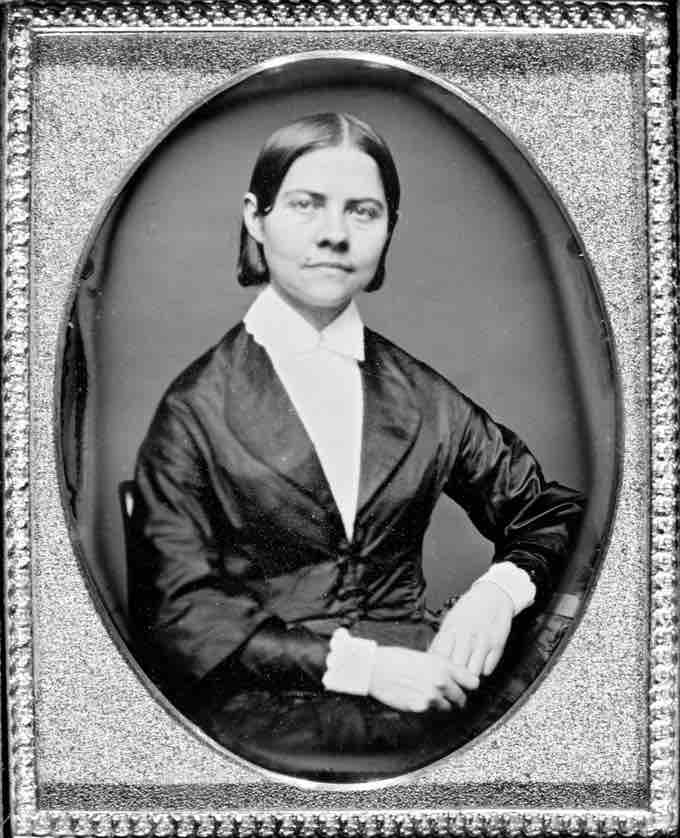Women's Rights of the Nineteenth Century
The movement for women's rights in the United States can be traced back to the late eighteenth and early nineteenth centuries. "First-wave feminism" refers to the feminist movement of the nineteenth through early twentieth centuries, which focused mainly on women's suffrage, or right to vote.
During the early part of the nineteenth century, agitation for equal suffrage was attempted by only a few individuals. The first of these was Frances Wright, a Scottish woman who came to the country in 1826 and advocated women's suffrage in an extensive series of lectures. In 1836, a Polish woman named Ernestine Rose came to the United States and undertook a similar campaign so effectively that she obtained a personal hearing before the New York Legislature, though her petition bore only five signatures. In 1840, Lucretia Mott and Margaret Fuller became active in Boston, the latter authoring the book The Great Lawsuit; Man vs. Woman. Gerrit Smith, who was the Liberty Party's candidate for president in 1848, successfully championed a plank in his party's position calling for women's equal rights.
Conventions and Resolutions
The first women's-rights convention was held in Seneca Falls, New York, in July of 1848. The Seneca Falls Convention was hosted by Lucretia Mott, Mary Ann McClintock, and Elizabeth Cady Stanton. Some 300 attended, including Frederick Douglass, who stood up to speak in favor of women's suffrage. After two days of discussion and debate, 68 women and 32 men signed a "Declaration of Sentiments," which outlined grievances and set the agenda for the women's-rights movement. A set of 12 resolutions was adopted, calling for equal treatment of women and men under the law and voting rights for women.
Elizabeth Cady Stanton, ca. 1880
Elizabeth Cady Stanton was an important early figure in the women's-suffrage movement in the mid-nineteenth century. Her "Declaration of Sentiments," presented at the Seneca Falls Convention in 1848, is often credited with initiating the first organized women's-suffrage movement in the United States.
Another advocate of women's rights was Lucy Stone. In 1850, she met with Paulina Kellogg Wright Davis, Abby Kelley Foster, William Lloyd Garrison, Wendell Phillips, and six other women to organize the larger National Women's Rights Convention. This national convention brought together for the first time many of those who had been working individually for women's rights. On the closing day, Stone gave a stirring speech to the 1,000-strong audience, which is said to have inspired Susan B. Anthony to join the cause.
While conventions provided places where women could support each other, they also highlighted some of the challenges of unifying many different leaders into one movement. Women's-rights activists faced difficult questions, such as: Should the movement include or exclude men? Who was to blame for women's inequality? What remedies should they seek? How could women best convince others of their need for equality? One goal, however, was clear: Attendees resolved to secure legal and social equality for women on par with men.

Lucy Stone, ca. 1840
Lucy Stone, the first American woman recorded to have retained her own name after marriage, was an important figure in the women's-rights movement of the nineteenth century and an organizer of the National Women's Rights Convention.
Progress and Gains
By 1860, women's-rights advocates had made some headway. In Indiana, divorces could be granted not only on the basis of adultery, but also on desertion, drunkenness, and cruelty. In New York, Indiana, Maine, Missouri, and Ohio, women's property rights had expanded to allow married women to keep their own wages. In 1860, New York passed a revised Married Women's Property Act, which gave women shared ownership of their children, allowing them to have a say in their children's wills and wages and granting them the right to inherit property.
The movement experienced further advances and setbacks in New York and other states, but feminists were able to use each new win as an example to apply more leverage on unyielding legislative bodies. Clearly there was still much to be done; however, reformers had given a name to women's oppression and had set into motion the movement that would continue to change American attitudes for years to come.
Critiques
The earlier forms of feminism have been criticized for being geared toward and focused on white, middle-class, educated women, to the exclusion of the diverse experiences of other women. Second- and third-wave feminist movements followed this initial first wave, working to further combat social, cultural, and political inequalities.